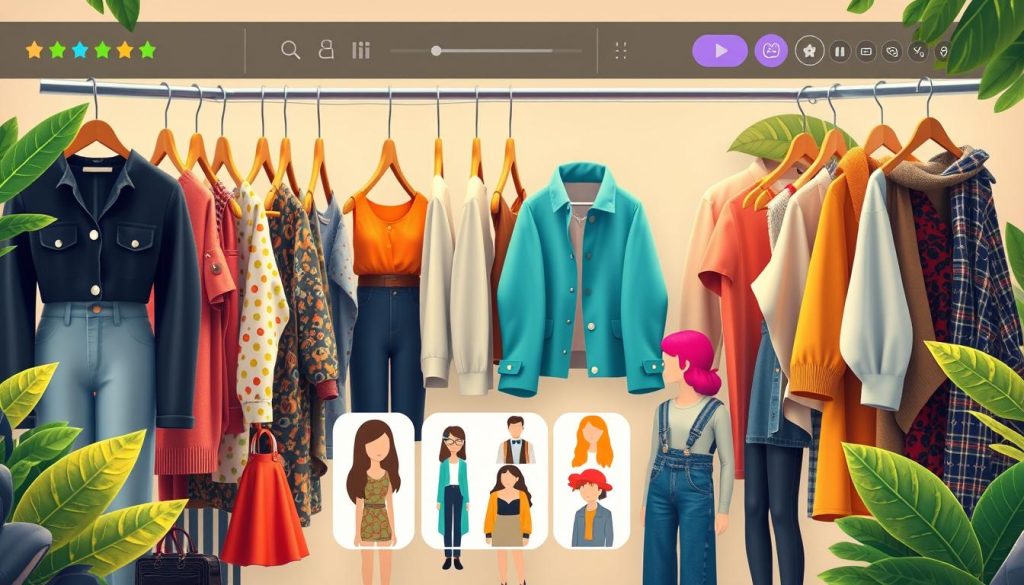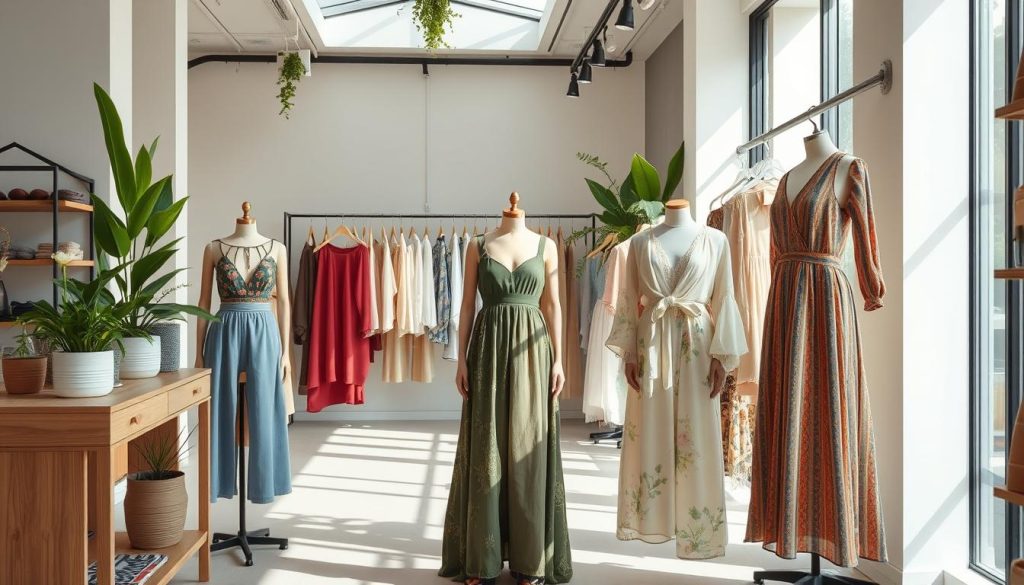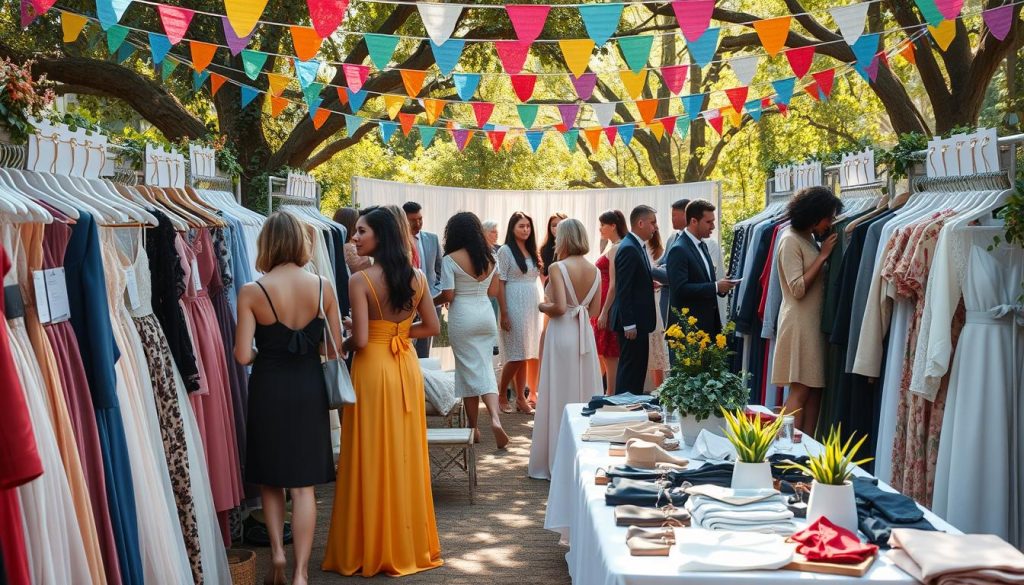I’ve found a great way to update my wardrobe without harming the planet. Clothing swaps are becoming popular for this reason. They let us swap clothes with others, so we don’t have to buy new things.
These swaps are not just good for the environment. They’re also a fun way to try out new styles. It’s amazing how swapping can make old clothes feel new again.
Being part of these swaps has many benefits. They help reduce waste in the fashion world. They also help us meet others who share our love for sustainable fashion.
What Are Clothing Swaps?
Clothing swaps are a fun way to update our wardrobes while helping the planet. They offer a green alternative to buying new clothes.
Definition and Concept
A clothing exchange is when people swap clothes they no longer want. It’s a way to recycle clothes and give them a second life.
History of Clothing Exchanges
Swapping clothes has been around for ages. But in the 1990s, organized swaps became more common. They were a response to the harm fast fashion causes. Now, events like Global Fashion Exchange show how popular sustainable fashion is becoming.
Benefits of Participating in Swaps
There are many good reasons to join clothing swaps:
- Save money on new outfits
- Reduce textile waste
- Discover unique pieces
- Declutter your closet
- Meet like-minded individuals
Swaps help us live in a more circular fashion economy. They let us enjoy new clothes while being mindful of our spending. Plus, they’re a great way to meet people who share your values.
The Environmental Impact of Fast Fashion
Fast fashion is harming our planet. I’ve seen how it pollutes water, creates textile waste, and increases carbon emissions. The numbers are shocking. The Ellen MacArthur Foundation says the fashion industry is responsible for 10% of global carbon emissions and uses 93 billion cubic meters of water every year.
Recycling textiles is key to solving these problems. But, less than 1% of clothes are recycled into new items. This waste ends up in landfills, releasing harmful gases as it breaks down. The World Resources Institute says a truckload of textiles is thrown away or burned every second.
Clothing swaps help by promoting a circular economy. They keep clothes in use longer, reducing the need for new ones and cutting down on waste. I’ve been part of swaps that saved hundreds of items from landfills. These events not only update our wardrobes but also teach us about sustainable fashion.
| Fast Fashion Impact | Clothing Swap Benefits |
|---|---|
| 10% of global carbon emissions | Reduces demand for new production |
| 93 billion cubic meters of water used annually | Conserves water resources |
| One garbage truck of textiles wasted every second | Extends garment lifespan, minimizes waste |
By supporting clothing swaps and circular economy ideas, we can lessen the fashion industry’s harm. I’ve seen how these small steps can greatly benefit our communities and the planet.
How to Organize a Successful Clothing Swap
Planning a clothing swap is a fun way to update your wardrobe and support sustainable fashion. I’ve helped organize many swaps and learned a lot. Here are my top tips for a great event.
Choosing a Venue
Finding the right place is key. I like using community centers or big living rooms for small groups. For bigger events, think about renting a hall or teaming up with a local business. Make sure the space is well-lit and big enough for everyone to look around.
Setting Rules and Guidelines
Having clear rules makes the swap go smoothly. I limit how many items each person can swap and take. It’s usually one-for-one. I also ask everyone to bring clothes that are clean and in good shape.
Promoting Your Event
Get the word out about your swap on social media, local boards, and by telling friends. I make cool flyers that show the swap’s focus on sustainable fashion. Working with eco-friendly groups can also help more people come.
| Promotion Channel | Effectiveness | Cost |
|---|---|---|
| Social Media | High | Free |
| Community Boards | Medium | Low |
| Local Partnerships | High | Variable |
By following these steps, you’ll host a successful clothing swap. It will support sustainable fashion and bring people together.
Preparing Your Wardrobe for a Swap
I enjoy making my wardrobe fresh through clothing swaps. It’s a smart way to reuse clothes and explore new fashion ideas. Before I go to a swap, I prepare my items carefully. This way, I bring pieces that others will love.
First, I check each garment’s condition. I look for wear, stains, or damage. If something needs a small fix, I do it before the swap. Clothes that can’t be fixed, I might upcycle into something new.
Cleaning is key. I wash or dry clean each item to make sure they’re clean and ready. This is vital for a good swap experience.
When picking items, I follow Marie Kondo’s rule. I choose pieces that don’t make me happy but are still good. This helps me get rid of clothes I don’t use and find them a new home.
| Item Type | Preparation Steps |
|---|---|
| Clothing | Wash, iron, repair minor issues |
| Accessories | Clean, polish, fix clasps or zippers |
| Shoes | Clean, deodorize, repair soles if needed |
By following these steps, I make sure my swap items are valuable. This not only promotes reuse but also makes us think more about our fashion choices.
Clothing Swaps: A Sustainable Fashion Revolution
Clothing swaps are changing the fashion world. They’re not just fun; they’re leading to more sustainable fashion. This shift is towards using clothes in a circular economy.
Reducing Textile Waste
Clothing swaps help cut down on waste. They give old clothes a new life, keeping them out of landfills. This action helps clothes last longer and reduces the need for new ones.
Promoting Circular Economy in Fashion
At the core of swaps is the circular economy in fashion. They teach us to see our clothes as part of a system where nothing is wasted. It’s a way to be eco-friendly without losing style or variety.
Building Community Through Shared Resources
Clothing swaps build community. They bring people together, sharing clothes and ideas on living sustainably. These events start conversations about making ethical fashion choices.
Groups like Fashion Revolution support this movement. They show how our fashion choices matter. By joining swaps, we refresh our wardrobes and help make fashion more sustainable.
Online Platforms for Virtual Clothing Swaps

I’ve found that virtual clothing swaps are boosting sustainable fashion. These online platforms let me update my wardrobe from home. Let’s look at some top choices that are reshaping how we buy clothes.
Rehash Clothes is easy to use for swapping clothes. I just upload photos of items I want to trade, check out others, and set up swaps. It’s like having a huge shared closet online.
ThredUp is different, acting as an online consignment store. I send in my used clothes and get credit to shop their huge selection. It mixes the excitement of thrift stores with online shopping ease.
Swancy focuses on social swapping. I make a profile, connect with friends, and swap clothes within my circle. It’s like borrowing from a friend’s closet, but bigger.
| Platform | Model | Key Feature |
|---|---|---|
| Rehash Clothes | Direct Swap | Peer-to-peer exchanges |
| ThredUp | Consignment | Earn credit for clothes |
| Swancy | Social Network | Swap within friend groups |
The COVID-19 pandemic helped these platforms grow. With in-person swaps paused, people turned to online swaps. This change has made sustainable fashion more reachable than ever.
Upcycling and Repurposing: Giving Old Clothes New Life
Upcycling fashion is a creative way to give old clothes a new life. I enjoy finding new ways to make outdated pieces trendy and unique. This not only saves money but also helps with textile recycling.
DIY Clothing Transformation Ideas
There are many ways to update your wardrobe through upcycling. I like turning old jeans into shorts or making crop tops from oversized t-shirts. With a little creativity, you can do anything!
- Turn a plain sweater into a cardigan by cutting it down the middle
- Create a tote bag from an old pair of jeans
- Transform a maxi skirt into a chic sundress
Working with Local Designers
Working with local designers can elevate your upcycling projects. Their knowledge in textile recycling and fashion design can lead to amazing custom pieces. Many designers are dedicated to sustainable fashion and offer upcycling services.
The Art of Mending and Repairing
Learning basic mending skills is key to making your clothes last longer. I’ve learned how to patch holes, replace buttons, and fix loose seams. These skills save money and reduce waste.
| Mending Technique | Skill Level | Tools Needed |
|---|---|---|
| Sewing on buttons | Beginner | Needle, thread, buttons |
| Patching holes | Intermediate | Fabric patch, iron, needle, thread |
| Darning socks | Advanced | Darning needle, darning egg, yarn |
The Future of Sustainable Fashion: Beyond Swaps

I’m excited to explore what lies ahead for sustainable fashion. Clothing swaps are a good start, but the industry is changing fast. New technologies and business models are leading the way to a more circular economy in clothing.
Rental fashion is becoming popular. Companies like Rent the Runway let customers borrow designer outfits for special events. This cuts down on waste and makes high-quality clothes more accessible.
Blockchain technology is changing how we see supply chains. It lets brands track their products from start to finish. This ensures clothes are made ethically and reduces environmental harm.
Recycling technologies are also improving. Some companies can break down mixed fabrics into their original fibers. This could solve the big problem of recycling blended textiles in sustainable fashion.
Brands like Patagonia are at the forefront. They encourage customers to repair and reuse their products. They even buy back used items to resell or recycle. Eileen Fisher’s Renew program does the same, giving old clothes a new life.
| Sustainable Fashion Innovation | Environmental Impact | Consumer Benefit |
|---|---|---|
| Rental Fashion | Reduces waste from rarely worn items | Access to high-quality clothing at lower cost |
| Blockchain Technology | Improves supply chain efficiency | Increased transparency in product origins |
| Advanced Recycling | Decreases textile waste in landfills | More sustainable clothing options |
The future of sustainable fashion looks promising. As consumers, we can help by choosing brands that care about the planet. Together, we can make the clothing industry more circular and reduce our environmental footprint.
How Clothing Swaps Promote Conscious Consumerism
Clothing swaps are changing how we see fashion. I’ve seen how these events lead to a shift towards conscious consumerism. Trading clothes instead of buying new ones teaches us to value quality over quantity.
Being part of swaps has made me more aware of my buying habits. I now look for eco-friendly clothes that last longer and have less environmental impact. This change is spreading, questioning the fast fashion model.
Swaps offer more than just new clothes. They create a sense of community and encourage sharing. This fits perfectly with conscious consumerism, where we think about the bigger picture of our purchases.
| Traditional Shopping | Clothing Swaps |
|---|---|
| Encourages overconsumption | Promotes reuse and sharing |
| Often supports fast fashion | Extends lifespan of clothing |
| Minimal social interaction | Builds community connections |
| Focus on trends | Emphasis on personal style |
Clothing swaps have a big impact, not just on our wardrobes. They’re changing how we shop on a bigger scale. By swapping, we tell the fashion world we care about sustainability and ethics.
Clothing Swaps for Special Occasions and Specific Needs

Clothing exchanges are now for more than just everyday clothes. They cover special events and specific needs, making it easier and more practical to reuse clothes.
Formal wear swaps are becoming more popular. People trade dresses, suits, and tuxedos. It’s great for those big events where you want to look fancy but don’t want to spend a lot.
Maternity clothing swaps are a big help for expectant mothers. Since pregnancy is short, there’s no need to buy a whole new wardrobe. These swaps let moms-to-be swap clothes as their bodies change.
Kids grow quickly, making children’s clothing swaps very useful. Parents can swap outgrown clothes for the next size, saving money and reducing waste.
| Swap Type | Benefits | Target Group |
|---|---|---|
| Formal Wear | Save money on expensive outfits | Party-goers, job seekers |
| Maternity | Adapt to changing body sizes | Expectant mothers |
| Children’s | Keep up with rapid growth | Parents, guardians |
Organizations like Brides Do Good focus on wedding dress exchanges. They collect and resell gowns, using the money to help charities fighting child marriage. It’s a lovely way to give your dress a second chance while helping others.
These special clothing exchanges do more than just reuse clothes. They also help build communities. They bring people together, creating bonds beyond just swapping clothes.
The Global Impact of Clothing Swaps
Clothing swaps are making a big splash worldwide. They’re changing how we view fashion. These events have grown from local meetups to a global movement for sustainable fashion.
Fashion Revolution Week is a prime example. It’s a global event that encourages clothing circulation. During this week, people from all over swap clothes. This action greatly reduces textile waste. The Global Fashion Exchange also organizes swaps in big cities worldwide.
Studies show that swaps have kept millions of pounds of textiles from landfills. This is a huge win for our planet. These events also teach people about sustainable fashion choices. It’s incredible to see how a simple idea can have such a big impact.
As more people join, the future of clothing swaps looks bright. They’re not just changing what we wear – they’re changing how we think. By promoting reuse and sharing, we’re building a greener fashion industry. It’s exciting to be part of this shift towards smarter, greener clothing choices.

